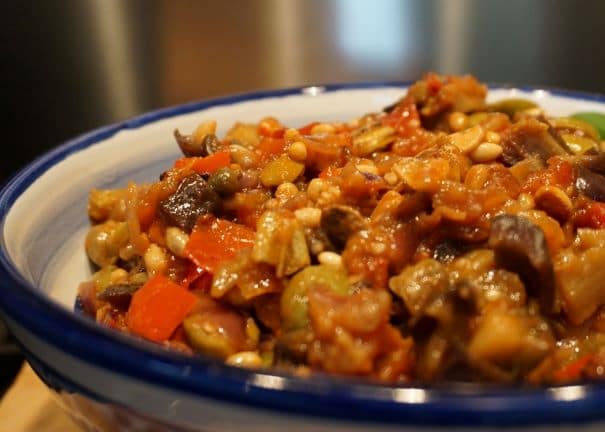
Caponata Siciliana di Agrigento
Although today we are used to finding all kinds of fruit and vegetables in the supermarkets all year round, it is better to follow seasonality. The fruits usually taste much better because they are harvested when they are riper, and the short transport distances have less impact on the environment. Among the vegetables of summer is also the protagonist of this recipe: the aubergine. Sicilian caponata is a wonderful vegetarian dish that can be enjoyed hot or cold. This delicious tasting dish, created by combining a few ingredients, is usually used as a side dish or appetiser.
Each Sicilian region has its own variation and there are many interesting ideas about the origin of the dish. In the Mediterranean alone, there are up to 36 different caponata variations, all of which have one thing in common: The main ingredients are various vegetables, which are all cut more or less the same size and given a slightly sweet and sour touch with vinegar and sugar. We present you our favourite Agrigento version, and we don’t really care which origin story is true.
Ingredients
- 800 g-1 kg aubergines (eggplant) – diced into pieces of 1x1cm
- 300 g-400 g celery (sticks only) – cut into 0,5 cm pieces
- 1 red pepper – cut into 1 cm pieces
- 200 g green olives without stones – halved
- 500 g ripe tasty tomatoes – diced into pieces of 1x1cm (or one can of diced tomatoes)
- 50 g capers preferably salted
- 60 g pine nuts
- 60 g sultanas or raisins
- 2 onions
- 2 gloves of garlic
- Some leaves of fresh basil
- 30 g sugar
- 30 g white wine vinegar
- salt (preferably sale grosso)
- sunflower oil
- extra virgin olive oil
Method
- Cut the aubergines into cubes, sprinkle with coarse salt and mix well. Leave to stand in a sieve for at least 1 hour to drain off the vegetation water and remove the bitterness.
- Dice the celery, put it in a pot with boiling water and a little salt and cook for 5 minutes until soft. Then drain well.
- Chop the onions and fry them in a pan with a little olive oil over a low heat.
- Add the capers, olives, sultanas and pine nuts and cook over a high heat for 10 minutes, stirring constantly. Add a little water if necessary so that nothing burns.
- Cut the tomatoes into cubes and sauté them in the pan with the onion mixture for at least 20 minutes so that they lose their water and everything is well mixed.
- Fry the celery in a pan with a little extra virgin olive oil.
- Drain and dry the aubergines and fry them in 50 ml of sunflower. Once fried, drain and add to the mixture with the onions. Add the celery and stir over a medium heat for 3-4 minutes.
- Then carefully add first the vinegar and then the sugar. Taste in between to achieve the desired ratio of sweet and sour. Allow the liquid to evaporate, turn off the heat and serve the caponata with some fresh basil.
Tips and tricks
- If there is any left over, the caponata can be stored in an airtight container in the fridge for at least a couple of days.
- To prepare a perfect Sicilian caponata, the aubergines must be cleaned properly: that is, wash and dry them well, then put them in a bowl, sprinkle with coarse salt and cover with a weight so that they lose their water and the bitter taste disappears. After an hour, rinse with cold water and drain well.
- Caponata can be served as a classic side dish, but also as finger food when combined with croutons or served in small glasses.
Regional variations of Sicilian caponata
- Caponata from Trapani: It is prepared with aubergines, peppers, onions, ripe tomatoes, celery, green olives, capers, vinegar, sugar and roasted almonds.
- Caponata from Catania: It is prepared with aubergines, yellow and red peppers, tomatoes, onions, celery, white or black olives, capers, vinegar, oil, salt and sugar.
- Caponata from Naples: The Neapolitan caponata is completely different from the Sicilian one and has nothing to do with the Sicilian recipe: it is rather a fresella made of soaked wheat seasoned with fresh tomatoes, garlic, oil, oregano and basil.
The origin of Caponata
- One hypothesis about the origin of the name of this dish says that it derives from the Greek word “capto”, which means the verb “to cut”, since all the ingredients used to prepare caponata are cut into pieces.
- The second hypothesis is that the name derives from the Latin word “caupona” for tavern: Indeed, sailors used to stop at taverns and eat a bread seasoned with capers, anchovies and oil, so the name refers to the origins of this poor but very filling dish.
- However, the generally accepted hypothesis in Sicily is that the name derives from the name of the fish “Capone” (Italian Lampuga). It is a fish found in the Mediterranean Sea, which in the past was often served in a sweet and sour sauce and was only eaten by those who had money or property. Over time, and especially in the interior of Sicily, lampuga was replaced by aubergine so that the less wealthy classes could also enjoy this dish.
- The actual origin of the name remains a mystery, but what is certain is that caponata, whether prepared with lampuga or aubergine, is a dish that you should definitely have tried more than once in Sicily.


